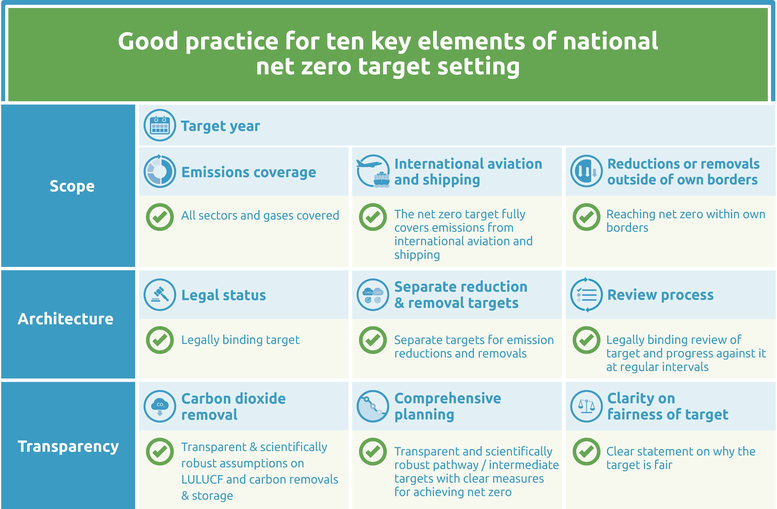Net zero targets
Summary
We evaluate the net zero target as: Poor
In September 2022, The Gambia submitted its Long-Term Strategy (LTS) for “climate neutral” development by 2050 (Republic of The Gambia, 2022). This document outlines The Gambia’s implementation strategy for achieving net zero GHG emissions by 2050. The Gambia’s 2050 Climate Vision and updated NDC also state this target (Republic of The Gambia, 2021b, 2021a).
Although The Gambia provides a comprehensive plan for reaching net zero GHG emission by 2050, the document does not include transparent quantifiable targets for how The Gambia will switch its LULUCF sector from a net carbon source to a net carbon sink by 2050 (Republic of The Gambia, 2022). The Gambia’s net zero target does not cover the industrial sector which accounts for 19% of total emissions, but it does cover all gases.
To improve the comprehensiveness of its net zero target, The Gambian government chould consider some of the good practice approaches below such as covering all GHG emissions under the target, clarifying the level of net negative GHG emissions coming from the LULUCF sector by 2050, and passing its net zero target into law.
CAT analysis of net zero target
Ten key elements
Scope
- Target year – The Gambia aims to reach net zero by 2050.
- Emissions coverage – The Gambia states in its LTS that it aims for net-zero greenhouse gas emissions by 2050. Though the target covers all gases, it does not cover all sectors. The LTS covers energy (consisting of the sub-sectors electricity and transport), agriculture, waste, and LULUCF, which represents 81% of The Gambia’s total emissions (Gütschow et al., 2021; Republic of The Gambia, 2020). 95% of GHG emissions is the threshold for a better evaluation according to the CAT methodology.
- International aviation and shipping – The Gambia provides no information on its intention to cover international aviation and shipping.
- Reductions or removals outside of own borders – The Gambia plans to reach net zero through domestic actions and will not use removals outside its borders. The Gambia plans to achieve this only through mitigation action in the energy, agriculture, waste, and LULUCF sectors.
Target architecture
- Legal status – The Gambia included its net zero target in its LTS which it submitted to the UNFCCC in September 2022 as well as in its 2050 Climate Vision and its latest NDC (Republic of The Gambia, 2021b, 2021a, 2022).
- Separate reduction & removal targets – The Gambia specifies separate emission reduction and removal targets. The Gambia plans to decarbonise the power sector, decrease GHG emissions in the transport and agriculture sector, and achieve a net GHG sink in the LULUCF sector by 2050.
- Review process – The Gambia is in the process of establishing a monitoring framework for its net zero target. The Gambia will develop a monitoring framework, which will include a monitoring and evaluation (M&E) plan as well as a monitoring, reporting, and verification system (MRV). This framework will enable The Gambia to review and update its LTS every five years.
Transparency
- Carbon dioxide removal – The Gambia does not plan on using carbon removal and storage, but it does plan on using the LULUCF sector as a net carbon sink by 2050. The Gambia provides a LULUCF pathway but does not indicate how large of a net carbon sink the LULUCF sector will provide by 2050. Currently, The Gambia’s LULUCF sector is a net carbon source.
- Comprehensive planning – The Gambia plans to use the same governance structure that oversees the implementation and revision of its NDCs for the five-year review cycle of its LTS. The LTS also provide high-level cost estimates and timelines for the mitigation measures that it plans to implement in order to achieve net zero GHG emissions by 2050. The net zero goal has interim targets for 2025 and 2030.
- Clarity on fairness of target – The Gambia’s 2050 Climate Vision explains that the target is fair since The Gambia’s contribution to climate change has always been marginal (Republic of The Gambia, 2021b).
Good practice
The Climate Action Tracker has defined the following good practice for all ten key elements of net zero targets. Countries can refer to this good practice to design or enhance their net zero targets.

Further analysis
Latest publications
Stay informed
Subscribe to our newsletter




